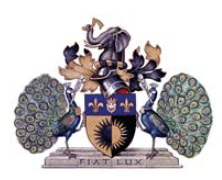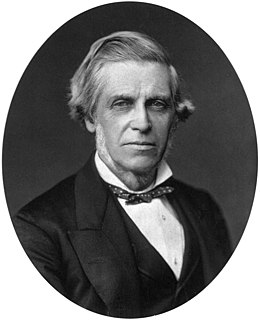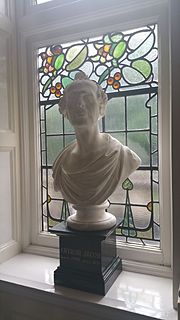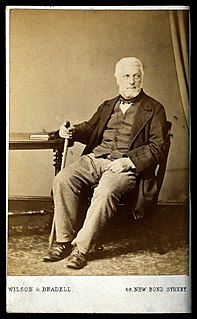
Ophthalmology is a branch of medicine that deals with the diagnosis and treatment of eye disorders. An ophthalmologist is a physician who specializes in eye care. Ophthalmologists typically provide specialty eye care - medical and surgical. Ophthalmologists may also participate in academic research for eye disorders.

Moorfields Eye Hospital is a specialist NHS eye hospital in Finsbury in the London Borough of Islington in London, England run by Moorfields Eye Hospital NHS Foundation Trust. Together with the UCL Institute of Ophthalmology, which is adjacent to the hospital, it is the oldest and largest centre for ophthalmic treatment, teaching and research in Europe.

Sir William Bowman, 1st Baronet was an English surgeon, histologist and anatomist. He is best known for his research using microscopes to study various human organs, though during his lifetime he pursued a successful career as an ophthalmologist.

Sir Charles Bell was a Scottish surgeon, anatomist, physiologist, neurologist, artist, and philosophical theologian. He is noted for discovering the difference between sensory nerves and motor nerves in the spinal cord. He is also noted for describing Bell's palsy.

Alexander Dalrymple FRS was a Scottish geographer and the first Hydrographer of the British Admiralty. He was the main proponent of the theory that there existed a vast undiscovered continent in the South Pacific, Terra Australis Incognita. He produced thousands of nautical charts, mapping a remarkable number of seas and oceans for the first time, and contributing significantly to the safety of shipping. His theories prompted a number of expeditions in search of this mythical land, until James Cook's second journey (1772–1775) led to the conclusion that, if it did exist, it was further south than the 65° line of latitude South.

Henry Bence Jones FRS was an English physician and chemist.

Chevalier John Taylor was an early British eye surgeon, self-promoter and medical charlatan of 18th-century Europe. He was noted by Samuel Johnson, and associated with the surgical mistreatment of George Frideric Handel, Johann Sebastian Bach, and perhaps hundreds of others.

William Dalrymple Maclagan was Archbishop of York from 1891 to 1908, when he resigned his office, and was succeeded in 1909 by Cosmo Gordon Lang, later Archbishop of Canterbury. As Archbishop of York, Maclagan crowned Queen Alexandra in 1902.

Dr Douglas Moray Cooper Lamb Argyll Robertson FRSE, FRCSEd LLD was a Scottish ophthalmologist and surgeon. He introduced physostigmine into ophthalmic practice and the Argyll Robertson pupil is named after him. He was president of the Royal College of Surgeons of Edinburgh.

Thomas Wharton Jones was an eminent ophthalmologist and physiologist of the 19th century.

William Mackenzie was a Scottish ophthalmologist. He wrote Practical Treatise of the Diseases of the Eye, one of the first British textbooks of ophthalmology.

Jacob Hermann Knapp, also known as Hermann Knapp, was a German-American ophthalmologist and otolaryngologist.

Arthur Jacob (1790–1874) was an Irish ophthalmologist. He is known for founding several hospitals, a medical school, and a medical journal. He contributed to science and academia through his 41-year term as Professor of Anatomy at the Royal College of Surgeons in Ireland (RCSI) and as the first Irish ocular pathologist. He was elected President of RCSI in 1837 and 1864.

John Thomas Quekett was an English microscopist and histologist.

Sir George Andreas Berry LLD, FRSE, FRCSEd was a Scottish ophthalmic surgeon who acquired a reputation as a leading authority on ophthalmology, not only in the United Kingdom but also in the United States and continental Europe. His standing in the profession was largely the result of his textbooks of ophthalmology which were widely used in his home country and abroad. His working career was spent at the Royal Infirmary of Edinburgh and when he retired from clinical practice in 1905 he became involved in medical and national politics. He was surgeon-oculist in Scotland to King George V and then to King Edward VII and was president of the Royal College of Surgeons of Edinburgh from 1910 to 1912. He was knighted in 1916. At the 1922 general election he was elected as Member of Parliament for the Combined Scottish Universities, sitting as a Scottish Unionist. He held the seat until he stood down at the 1931 general election.

George Gulliver, was an English anatomist and physiologist.
William Dalrymple was an English surgeon. He learned his trade in London and practised in Norwich, initially from his father's house and later in the Norfolk and Norwich Hospital. He received attention for successfully performing of the then rare operation of tying the carotid artery.

James Ware (1756–1815) was an English eye surgeon, and Fellow of the Royal Society, who practiced in London during the Georgian era. He is considered one of the founding fathers of modern ophthalmology in Britain.

Dr John Thomson FRS FRSE PRCPE (1765–1846) was a Scottish surgeon and physician, reputed in his time "the most learned physician in Scotland". He was President of the Royal College of Physicians of Edinburgh from 1834 to 1836.

Dr Henry (Harry) Moss Traquair, FRSE, PRCSE was a Scottish ophthalmic surgeon who made important contributions to the science of perimetry and the use of visual field testing in the diagnosis of disease. He was President of the Royal College of Surgeons of Edinburgh in 1939/40 and President of the Ophthalmological Society of the United Kingdom.



















